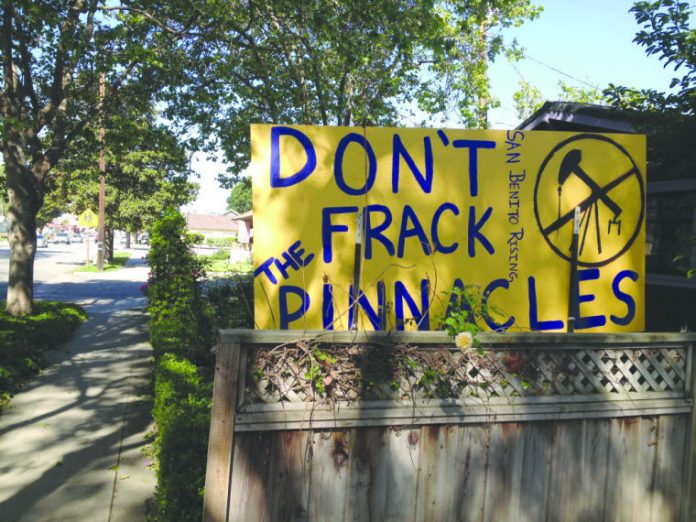
BACKGROUND: The San Benito County Board of Supervisors passed Ordinance 918 at the June 18, 2013 meeting. This ordinance allows Project Indian to stimulate oil/gas well utilizing hydraulic fracturing (fracking) and other advanced processes. About a week later, the Center for Biological Diversity filed suit opposing Project Indian for an inadequate environment impact report. In July 2014, the court ruled in favor of the CBD.
Note: This is part of a new feature in which two writers share opposing views on local topics.
BACKGROUND: The San Benito County Board of Supervisors passed Ordinance 918 at the June 18, 2013 meeting. This ordinance allows Project Indian to stimulate oil/gas well utilizing hydraulic fracturing (fracking) and other advanced processes. About a week later, the Center for Biological Diversity filed suit opposing Project Indian for an inadequate environment impact report. In July 2014, the court ruled in favor of the CBD.
In September 2013, Governor Brown signed SB-4 into law. Per the LEGISLATIVE COUNSEL’S DIGEST – “This bill would define, among other things, the terms well stimulation treatment, hydraulic fracturing, and hydraulic fracturing fluid. The bill would require the Secretary of the Natural Resources Agency, on or before January 1, 2015, to cause to be conducted, and completed, an independent scientific study on well stimulation treatments, including acid well stimulation and hydraulic fracturing treatments.”
The BOS passed Resolution No. 2014-67 at the July 8, 2014 meeting that will submit the following question to the voters at the November 2014 election: “Shall San Benito County’s General Plan be amended to ban High-Intensity Petroleum Operations (such as hydraulic Fracturing, also known as fracking, acid well stimulation, and cyclic steam injection, but not Low-Intensity Petroleum Operations) throughout all unincorporated areas, and all Petroleum Operations in residential general plan designations of Rural, Rural transitional, Rural Residential, Rural/Urban, and Sphere of Influence Rural/Urban, with related zoning changes to implement the new General Plan policies?” It will appear on the November ballot as Measure J. Voters are to vote YES or NO. This initiative was in response to San Benito Rising’s efforts to prevent fracking. A NO vote is recommended.
Monterey Shale: The Monterey Shale formation extends from south of Bakersfield to north of Modesto. It extends into the southeastern quadrant of San Benito County. It contains a massive amount of oil and gas. A University of Southern California study estimated the Monterey Shale has the potential to create as many as three million jobs and add as much as $24 billion to the state’s revenue stream in the years to come.
The estimates of recoverable oil vary considerably, from over 10 billion barrels to less than 1 billion barrels. Economical recovery will require hydraulic fracturing and/or other advanced extraction techniques.
SB-4 – The Division of Oil, Gas and Geothermal Resources of the Department of Conservation will implement the regulations required by SB-4 before 1 January 2015. Operators will be required to obtain a permit and perform specific testing, evaluations, and analysis prior to commencing well stimulation treatments. Operators must disclose detailed information about the stimulation treatments, chemicals to be used, and their concentrations. Operators must notify property owners, neighbors, and tenants before stimulation. Also, neighbors can request baseline and follow-up testing of their qualifying water wells.
Apparently, San Benito Rising cannot wait two months for the results of SB-4. They, with the encouragement of CBD, obtained the necessary signatures to have Measure J placed on the November ballot
Emotions have trumped science, economics, personal property rights, and common sense.
In May of this year, Andy Hsia-Coron stated: “Very little oil and gas drilling is happening yet in San Benito County. Our county like many others sits atop the Monterey Shale formation. The industry plans on the Monterey Shale being its next big oil play. So, at this point with little drilling there is little evidence of water contamination.” – BenitoLink.
Fact – Oil was discovered in San Benito County in 1864. Commercial production started shortly thereafter and has continued since. (Quicksilver Country, page 51.)
Fear – Fracking will contaminate our drinking water.
Fact – According to the American Water Works Association and the U.S. Environmental Protection Agency, there are no recorded events of contaminated aquifers in the United States as a result of oil/gas exploration and mining, including 60 years of fracking. There is no causal link of pollution/contamination between oil/gas wells and water supplies.
Jeff Cattaneo, district manager/engineer for the San Benito County Water District, stated that to date existing oil/gas wells in San Benito County have not caused pollution or contamination of groundwater in San Benito County. That is 150 years!!!
Also, the average shale formation is thousands of feet underground, while the average drinking well or aquifer is a few hundred feet deep. Separating the two is solid rock.
Fear – Fracking releases toxic or radioactive chemicals.
Fact – The reality is that 99.5% of the fluid injected into fracture rock is water and sand. The chemicals range from the benign, such as citric acid (found in citrus fruit and soda pop), to benzene. (Wall Street Journal June 25, 2011.)
Fear – Massive amounts of water is required to frack a well.
Fact – Kern County has hundreds of oil/gas wells that have been fracked. In 2011, the average water used was about 125,000 gallons per well. By comparison, a normal household, family of four, used about 135,000 gallons. The amount of water used for fracking in Kern County is small compared to the amount of water used for agriculture in Kern County.
Fear – Fracking will cause earthquakes.
Fact – Fracking can cause earthquakes the same as returning treated water and/or sequestering carbon dioxide in deep wells. Too much water injection can cause earthquakes. However, the magnitude of these quakes is small and often not even felt.
Other Considerations – Expansion of the oil/gas industry in the county would provide employment in both the oil/gas area and in general economic activity in the county.
With fracking, San Benito County will contribute to the United States becoming independent of foreign energy sources.
California currently imports much of its energy from other states and countries. Fracking would help the state economy as well.
The U.S. is producing so much natural gas that the cost has dropped from over $12 per unit in 2008 to less than $5 now. The terminals designed for importing liquid natural gas are being converted to terminal for exporting liquid natural gas. San Benito County can actually help the country’s international balance of payments.
Apply common sense and vote NO on Measure J. We should at least wait for the results of the SB-4 study.









